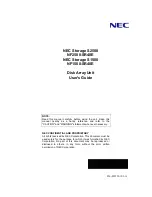
Chapter 7: Technology Background
235
Choosing Stripe Size
Stripe Size, also called “Stripe Block Size”, refers to the size of the data blocks
written to, and read from, the physical drives. Stripe Size is specified when you
create a disk array. In order to change the Stripe Size of an existing disk array,
you must delete the disk array and create a new one. You can select Stripe Size
directly when you use the Advanced function to create a disk array. If you use the
Express function to create a disk array, WebPAM PRO selects the Stripe Size
when you choose an Application Type.
The available Stripe Sizes are 64, 128, 256 KB, 512 KB, and 1 MB. 64 KB is the
default. There are two issues to consider when selecting the Stripe Size.
First, you should choose a Stripe Size equal to, or smaller than, the smallest
cache buffer found on any physical drive in the disk array. Selecting a larger
value slows read/write performance because physical drives with smaller cache
buffers need more time for multiple accesses to fill their buffers.
Second, if your data retrieval consists of fixed data blocks, such as with some
database or video applications, then you should choose that size as your Stripe
Size.
If you do not know the cache buffer or fixed data block sizes, Promise suggests
you select 64 KB as your Stripe Size. Generally speaking, email, POS, and
webservers prefer smaller stripe sizes. Video and database applications prefer
larger stripe sizes.
Choosing Sector Size
A sector is the smallest addressable area on a physical disk drive. Sector Size
refers to the size of sector measured by the number of bytes of data it can hold.
The most common sector size is 512 bytes (512 B). A smaller sector size results
in a more efficient use of a disk drive’s capacity. 512 B is the default sector size
for logical drives on SuperTrak.
The number of usable sectors is limited by the addressing method of the
computer's operating system:
•
Windows 2000 and Windows XP (32-bit) support 10-bit logical bit addressing
(LBA), so with 512 B sectors, they can only support up to 2 terabytes (TB) of
data storage capacity. To increase the capacity, you must use larger sectors.
See “2 TB Limitation” on page 236.
•
Windows XP (64-bit), Windows 2003 Server, and Windows Vista support 64-
bit LBA, so they are not affected by this limitation. For these OSes, always
choose the default 512 B sector size.
•
Linux operating systems with the 2.4 kernel do not support variable sector
sizes. For these OSes, always choose the default 512 B sector size.
Summary of Contents for E310f
Page 1: ...VTRAK E Class E310f and E310s PRODUCT MANUAL Version 1 1 ...
Page 14: ...VTrak E Class Product Manual xiv ...
Page 22: ...VTrak E Class Product Manual 8 ...
Page 58: ...VTrak E Class Product Manual 44 ...
Page 61: ...Chapter 4 Management with WebPAM PROe 47 Figure 1 The WebPAM PROe log in screen ...
Page 218: ...VTrak E Class Product Manual 204 ...
Page 234: ...VTrak E Class Product Manual 220 Figure 13 Replacing the VTrak controller ...
Page 304: ...VTrak E Class Product Manual 290 ...
Page 316: ...VTrak E Class Product Manual 302 ...
















































